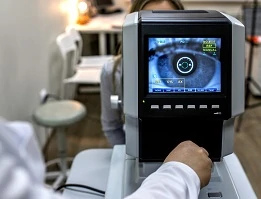LASIK Clinical Trials: The Science Behind Laser Eye Surgery

Clinical research is often at the core of news stories about health and medicine. Whether on TV, in a newspaper, or online, it’s likely you’ve seen reports about the latest “clinical study” or “clinical research”. With compelling stats, findings, and comparisons, scientific research often makes good headlines. However, headlines – or news stories for that matter – can’t cover the depth and breadth of the information presented in clinical research.
Why? There is a lot of diversity in how science develops. Some clinical research is conducted over months and years by scientists and the reports of those studies are incredibly detailed, running 20 to 100 pages or more. You can access our library of research, which we regularly update, here.
Some published clinical work simply reports on a single, unusual patient – just one person – to serve as a cautionary experience for healthcare professionals. You may ask:
What exactly is clinical research?
Clinical research is a scientific exploration or investigation into the performance of a drug, medical device, or treatment regimen with the primary goal of determining whether it is safe and effective for patients. It begins with a hypothesis – this is an educated guess about the treatment and its ability to provide a certain benefit. Research is then conducted to test whether the hypothesis is true or false. Research can take many different forms, but essentially data is collected, analyzed in the context of the hypothesis, and then the findings are reported. The findings of clinical research determine which drugs, devices, and treatments are approved for use and often compare them to previously approved treatments.
Importantly, clinical research builds our knowledge about prevention, treatment, and diagnosis. That knowledge serves as the consensus for what the scientific community believes to be true, based on the evidence available.
LASIK Clinical Trials: The Science Behind Laser Eye Surgery
LASIK is a case in point. LASIK is one of the most studied elective procedures performed today. More than 9,000 patients participated in FDA clinical trials alone from 1993-2005. Over time, a tremendous about of clinical research into LASIK has been conducted – to date more than 7,000 peer-reviewed published studies, in fact – to confirm the LASIK procedure is both safe and effective as well as look into other important aspects. In recent studies conducted, the LASIK success rate reports that 99% of patients achieve better than 20/40 vision and more than 90 percent achieve 20/20 or better. This includes studies that help refine what makes a patient a good or bad candidate for the LASIK procedure and techniques and technologies that can reduce the potential for side effects such as dry eye, glare, and halos.
Clinical studies have tested the many improvements in LASIK since the procedure was first approved. In medicine, technologies and techniques evolve and advance over time. LASIK is no different. Today’s excimer lasers – the lasers that reshape the cornea to improve vision – are more precise and easier to work with than earlier models. Newer lasers and technologies can customize the procedure to the specific shape and thickness of a patient’s cornea and treat a broader range of vision impairments. These advances lead to better visual outcomes and a safer procedures for more people.
Who conducts LASIK clinical trials?
The clinicians – the scientists – who work with LASIK are committed to an ongoing process of improvement in the procedure. These doctors continually ask questions as a means of finding potential in LASIK. There is a reason “quest” is the root of the word “question.” This illustrates that scientific exploration is a process, a path – not necessarily a destination. The question is the beginning, not the end.
It is important to put clinical findings in their appropriate context. No one study has a final, definitive answer about any medical treatment, device, procedure, or drug. By definition, a study has a very specific scope of work – a specific question it is trying to answer. While the results of a single study can be compelling, interesting, and encouraging, they are only a piece of a bigger and growing body of science. Understanding this context is important to preventing misinformation based upon misleading or even harmful claims rooted in clinical data.
What design and methodologies are used for LASIK clinical trials?
There are also many different study designs and methodologies, all of which serve a purpose, from large-scale prospective double-blind endeavors that take place over several years to a report of a case study of a single patient with no effect on the general population. Be skeptical about any reporting that describes dramatic conclusions from a single study.
In the case of LASIK, there is tremendous confidence, based upon an extraordinarily large amount of clinically-based evidence, that the LASIK procedure is safe and effective. It isn’t perfect, because nothing is. However, it ranks among the most thoroughly investigated, most effective, and safest procedures performed today.
The Refractive Surgery Council (RSC) Editorial Advisory Board is comprised of some of the world’s leading refractive surgeons, thought-leaders, and innovators that review and approve our articles, as well as identify and interpret the latest findings in the field of refractive surgery. The Refractive Surgery Council Verified Seal means that every article we share represents the highest standards in the field of refractive surgery.




